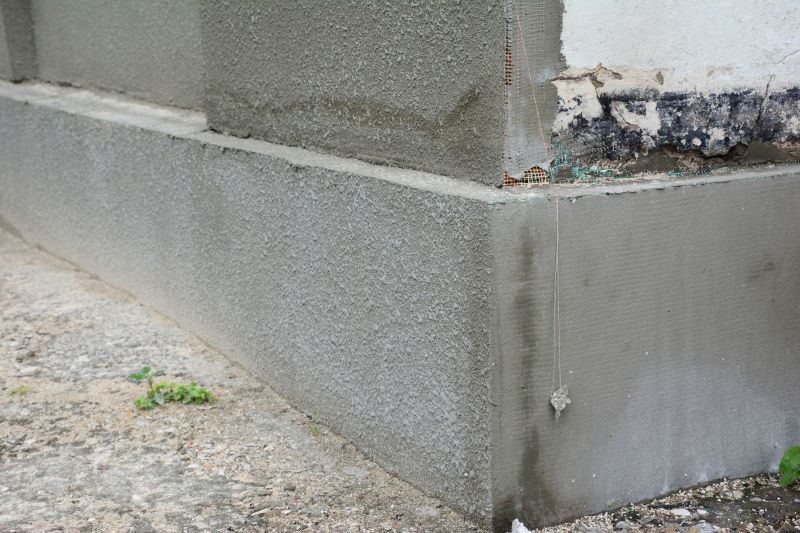Top-Rated Products For Foundation Stabilization And Soil Support
Identify high-quality foundation repair products that improve soil stability and enhance your home's foundation.
 Foundation repairs are a critical aspect of maintaining the structural integrity of a building, especially in regions like Ann Arbor, MI, where soil conditions and weather patterns can influence foundation stability. When addressing foundation issues, a variety of products are available to help stabilize, lift, and reinforce the foundation. These products range from simple repair kits to complex underpinning systems, each designed to suit different types of foundation problems and severity levels.
Foundation repairs are a critical aspect of maintaining the structural integrity of a building, especially in regions like Ann Arbor, MI, where soil conditions and weather patterns can influence foundation stability. When addressing foundation issues, a variety of products are available to help stabilize, lift, and reinforce the foundation. These products range from simple repair kits to complex underpinning systems, each designed to suit different types of foundation problems and severity levels.
Top Overall Option
Hydraulic Support and Lifting Systems
Hydraulic support and lifting systems are versatile tools used in foundation repairs to lift and stabilize sinking or uneven foundations. They typically consist of hydraulic jacks, piers, and stabilization brackets, allowing for precise adjustments and secure reinforcement. These systems are suitable for a range of foundation types and can be adapted for both minor and major repairs, providing a reliable method to restore levelness and structural stability. Proper installation by professionals ensures optimal performance and long-term durability.
Types of Products For Foundation Repairs
Hydraulic Jacks
Used to lift and level foundations, hydraulic jacks provide controlled force to realign settled structures.
Push Piers
Deep foundation support systems that transfer load to stable soil layers, suitable for significant settlement issues.
Helical Piers
Helical piers are screwed into the ground to stabilize and support foundations, especially in loose or variable soils.
Slab Jacking Materials
Materials used in slab jacking or mudjacking to lift and level concrete slabs over unstable soil.
Crack Injection Kits
Used to seal and stabilize cracks in concrete, preventing water intrusion and further damage.
Underpinning Systems
Support systems that extend the foundation to more stable soil layers, often involving piers or piles.
Soil Stabilization Products
Chemical or physical agents used to improve soil stability around foundations.
Foundation Repair Anchors
Anchors used to reinforce and secure basement or crawl space walls against bowing or shifting.
Waterproofing Membranes
Materials applied to foundation walls to prevent water infiltration and reduce soil moisture fluctuations.
Concrete Patching and Repair Materials
Products designed for repairing damaged or crumbling concrete surfaces on foundations.
Vibration and Compacting Equipment
Tools used to compact soil and improve foundation support during repair projects.
Drainage Systems
Drainage solutions like French drains to divert water away from foundations and reduce soil erosion.
Foundation Inspection Tools
Level, laser, and moisture meters to assess foundation condition before and after repairs.
Epoxy and Sealants
Used for sealing cracks and bonding concrete surfaces to restore strength and prevent water intrusion.
Popular Choices
Widely used for lifting and stabilizing foundations, these systems are favored for their versatility.
Commonly selected for deep foundation support, especially in cases of significant settlement.
Popular for their ease of installation and effectiveness in loose soils.
A frequently used method for sealing cracks and preventing water damage.
Often chosen for leveling concrete slabs without extensive excavation.
Popular for protecting foundation walls from moisture issues.
Used to reinforce basement walls and prevent bowing or shifting.
French drains and similar systems are common choices to manage water flow around foundations.
Frequently selected for quick and effective crack sealing.
Popular options for improving soil support in problematic areas.
Often used in preparation and repair phases to ensure soil stability.
Understanding the different options can help homeowners and contractors select the most appropriate solutions for their specific needs. It is important to consider factors such as the type of foundation, the extent of damage, and the underlying soil conditions. Proper installation and quality materials are essential to ensure long-term stability and safety.
Many foundation repair products are designed for both minor fixes and major structural interventions. For instance, hydraulic jacks can be used to lift and level a sinking foundation, while helical piers and push piers can provide deep foundation support in cases of significant settlement. Additionally, crack injection kits are useful for sealing and stabilizing small to medium cracks in concrete surfaces, preventing further deterioration.
In Ann Arbor, MI, where seasonal freeze-thaw cycles can impact soil movement, selecting products that accommodate soil shifts and moisture variations is especially important. Consulting with foundation repair specialists can help determine the most suitable products and methods to address specific foundation issues, ensuring the integrity of your property for years to come.
Key Buying Considerations
- Assess the specific type and extent of foundation damage before selecting products.
- Ensure compatibility of repair products with your foundation material, whether concrete, brick, or stone.
- Consider soil conditions and moisture levels in your area, especially in regions like Ann Arbor, MI.
- Evaluate whether the repair involves lifting, stabilization, sealing, or a combination of these functions.
- Look for products that are designed for long-term performance and durability.
- Check if professional installation is recommended or required for the chosen products.
- Review the product's capacity to accommodate future soil movements or seasonal changes.
- Select products with clear instructions and support from manufacturers or suppliers.
- Consider the ease of application and whether specialized tools or skills are needed.
- Review customer feedback and expert recommendations to gauge effectiveness and reliability.
- Factor in the cost relative to the scope of repair work, balancing quality and budget.
- Verify warranty options or guarantees offered with the products.
- Ensure that the products meet local building codes and safety standards.
- Think about the accessibility of repair sites and whether products can be used in tight or hard-to-reach areas.
- Determine if the products require ongoing maintenance or inspections.
